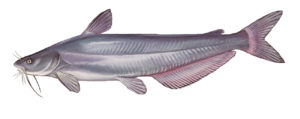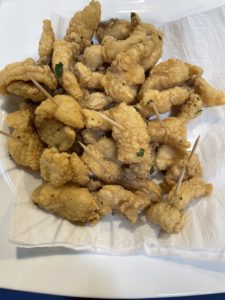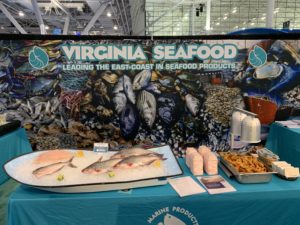June 25, 2024CELEBRATE NATIONAL CATFISH DAY WITH THE VMPB!

Today is National Catfish Day and the VMPB would like to highlight a relatively new member of the Virginia Seafood industry, the Wild Caught Blue Catfish. The Blue Catfish is a white meat fish that is mild and flaky. They are delicious because the adult Blue Catfish are not bottom feeders and don’t acquire a muddy taste which helps develop the flavor but is bad for our ecosystem in Virginia waters. The Blue Catfish is an invasive species that was turned loose by the Virginia Department of Game and Inland Fisheries in Virginia waters in the James, Rappahannock, and York River basins in the 1970s and 80s as a new recreational fishery since then the population has grown out of control in the Chesapeake Bay tributaries. This has had a very negative affect on Virginia’s native species.
Blue Catfish left on their own can grow upwards of five feet long and over 100 pounds. Blue Catfish spawn once a year and female Blue Catfish produce between 4,000 and 8,000 eggs per each kilogram of body weight. With the large spawn each year and their enormous appetite the effect on native seafood species in Virginia has been devastating. Blue Catfish feed on a wide variety of prey, including, Virginia’s Shad and Herring fisheries which have been heavily impacted by the population reduction caused by Blue Catfish. The Blue Catfish’s appetite is so large that it shapes the environment around it, the latest biomass study done on the James River shows that it is around 75% Blue Catfish. Blue Catfish have shown the ability to adapt to their environment as well. When food supply becomes scarce Blue Catfish have shown the ability to adapt to adapt the brackish water at the mouth of the river or tributary leading to the Chesapeake Bay they are currently in and years with heavy enough rainfall that the salinity level drops Blue Catfish have shown the ability to swim into the Chesapeake Bay to travel into another river or tributary.

Some of Virginia’s fisheries that are currently under threat of population reduction due to Blue Catfish are Striped Bass, Blue Crab, Menhaden, Clams, Oysters, along with many others. The good news is the Virginia Seafood industry can untap the potential of the Blue Catfish fishery. Blue Catfish can be harvested in a variety of ways including by pound nets, gill nets, pots, haul seine, and a new fishery using Low Frequency Electrofishing Technology, in which a generator supplies pulsed low frequency DC current that temporarily stuns the fish and causes them to surface to enable harvesting. Blue Catfish is also extremely sustainable, NOAA reported that over 3,500,000 pounds of Blue Catfish were landed in Virginia in 2022 and this amount harvested won’t even come close to reducing the replacement population growth. The VMRC, PRFC, and NOAA all recommend increased consumption of the Blue Catfish. Increasing the consumption of the Blue Catfish will not only have positive effect on limiting the spread of the species and promote a healthy population number, but it will also allow native species that have become targets of the Blue Catfish, a chance to recover their previous population size.

The VMPB has taken part in educating the public on the Blue Catfish, it’s history in the Commonwealth of Virginia, it’s affect on Virginia’s native species, and the unique delicious taste of the Blue Catfish compared to what they might be accustomed to. The VMPB has been involved in countless programs, events, and trade shows the previous few years where they have highlighted Wild Caught Blue Catfish, serving it to attendees while giving them the history of the Blue Catfish in Virginia and what give it that delicious unique taste compared to a farm raised or native catfish. The VMPB is also taking part in many digital and billboard campaigns now as well as over the previous years highlighting Wild Caught Blue Catfish and its importance to the Virginia Seafood industry. Wild Caught Blue Catfish has also shown up on VMPB sponsored news stories and cooking demos, where we highlight a variety of Blue Catfish and how it adheres to many different cooking methods, sauces, and spices.

One of the largest hurdles currently is on the processing end. Blue Catfish processing was originally regulated by the FDA, currently Blue Catfish is under USDA inspection. The change in regulations led to a lot of the processors in Virginia shutting down Blue Catfish production. Processors are adjusting to the USDA regulations and multiple companies have gotten back into processing in Virginia. More processors are becoming USDA certified in Virginia, with other Virginia processors looking into the option of processing Virginia Wild Blue Catfish. Individuals can also help by continuing to purchase fresh local seafood, including Wild Blue Catfish from nearby retailers, restaurants, and local seafood markets. Follow this link to our retailers’ page on this website and follow this link to the VMPB Fish Of The Day page if you would like to learn more about the Blue Catfish.
